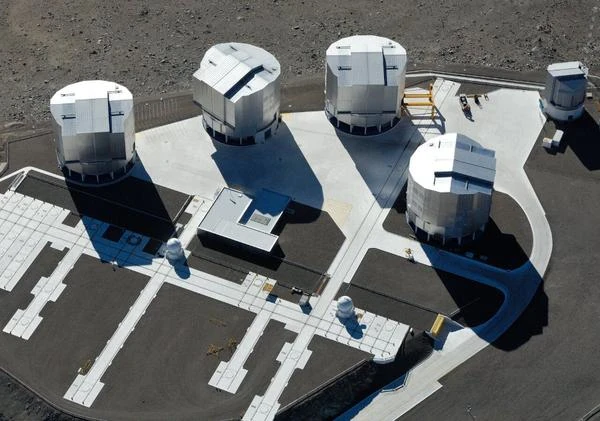
Image description: VLTI (Very Large Telescope Interferometer), combining 4 fixed telescopes and 4 mobile telescopes. Image source: ESO
An astronomical interferometer combines signals from multiple separate telescopes to achieve a resolution equivalent to that of a single telescope with a diameter equal to the maximum distance between the telescopes. The telescopes are often spaced several kilometers apart to maximize the resolution of images of very distant objects such as stars, quasars, black holes, or galaxies.
The signals are collected and directed to a central point where interference produces a high-resolution image, much more detailed than with a single telescope.
Interferometers also allow precise measurement of the distance between stars, which is crucial for understanding the structure of our galaxy.
Here are the most powerful interferometers, ranked by capacity and location:
| Interferometer | Agency / Observatory | Number of Telescopes | Telescope Diameter | Location | Comments |
|---|---|---|---|---|---|
| VLTI | ESO, Chile | 4 fixed + 4 mobile | 8.2 m | Paranal Observatory | Combines several telescopes to achieve exceptional resolution |
| Keck Interferometer | Keck Observatory, Hawaii | 2 | 10 m | Mauna Kea | Enables precise observations of stars and exoplanets |
| LBT Interferometer | Mount Graham Observatory, Arizona | 2 | 8.4 m | Arizona, USA | Binational Italian-American observatory |
| CHARA Array | Georgia State University, USA | 6 | 1 m | Mount Wilson, Georgia | Excellent for measuring stellar diameters and interstellar distances |
| MROI | Magdalena Ridge Observatory, New Mexico | 10 (under construction) | 1.4 m | New Mexico, USA | Will allow high-resolution imaging of multiple stars simultaneously |
These interferometers allow the study of: stellar evolution, planet formation, binary interactions, galactic structure, and the detection of circumstellar disks. They are now an essential tool for astronomers seeking to push beyond the limits of single telescopes.